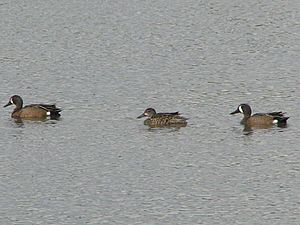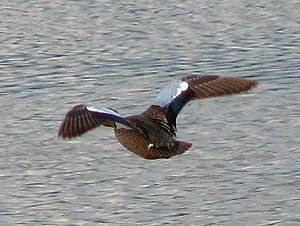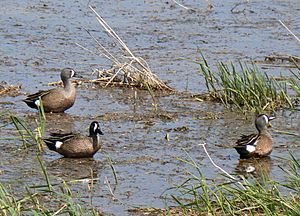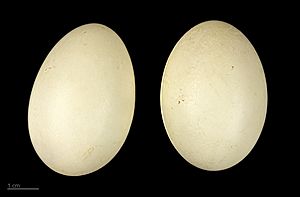Blue-winged teal facts for kids
Quick facts for kids Blue-winged teal |
|
|---|---|
 |
|
| Male in Texas | |
| Conservation status | |
| Scientific classification | |
| Genus: |
Spatula
|
| Species: |
discors
|
 |
|
| Synonyms | |
|
|
The blue-winged teal (Spatula discors) is a small and speedy duck that belongs to the duck, goose, and swan family, Anatidae. It's one of the smaller types of dabbling ducks, which means it feeds by tipping its body forward to reach food in shallow water, rather than diving. These ducks live in North America. They breed from southern Alaska all the way to Nova Scotia and as far south as northern Texas. When winter comes, they fly south to warmer places like the Pacific and Atlantic coasts, the Caribbean islands, and Central America.
Contents
What's in a Name?
The blue-winged teal got its official name from a Swedish scientist named Carl Linnaeus in 1766. He first called it Anas discors. Later, scientists studied its DNA and found it was a bit different from other ducks in the Anas group. So, they moved it to a new group called Spatula. This name was first suggested by a German zoologist in 1822.
The name Spatula is Latin for "spoon" or "spatula," which might refer to the shape of its bill. The word discors means "different" or "at variance" in Latin.
How to Spot a Blue-winged Teal

Blue-winged teals are about 40 centimeters (16 inches) long. Their wings can spread out to about 58 centimeters (23 inches) wide, and they weigh around 370 grams (13 ounces).
- Males: Adult males are easy to spot! They have a bluish-gray head with a bright white crescent shape on their face. Their body is light brown, with a white patch near their tail.
- Females: Adult females are mostly mottled brown, which helps them blend in. They have a whitish area at the base of their bill.
Both male and female blue-winged teals have bright sky-blue feathers on the top part of their wings. They also have a green patch on their wing called a speculum, and yellow legs. Males make a short whistling sound, while females have a soft quack.
Where Do Blue-winged Teals Live?
These ducks can be found across most of North America. They avoid the very northern parts of Alaska, Yukon, and the Northwest Territories, as well as the far northeastern parts of Canada. They are not very common in the desert southwest or along the west coast.
Breeding Grounds
Blue-winged teals love to breed in marshes and ponds. Their breeding areas stretch from east-central Alaska and southern Mackenzie District in Canada, all the way east to southern Quebec and southwestern Newfoundland. In the United States, they breed from northeast California east to central Louisiana, central Tennessee, and the Atlantic Coast.
Winter Homes and Travel
When it gets cold, blue-winged teals fly south in large groups. They are usually among the first ducks to head south in the fall and the last to return north in the spring. Some even fly long distances over the ocean!
They spend their winters in places like southern California, western and southern Texas, the Gulf Coast, the Caribbean, and even further south into Central America and South America. You can often see them as far south as Brazil and central Chile. Sometimes, they even wander to Europe!
What Kind of Home Do They Like?
Blue-winged teals prefer calm or slow-moving water, like inland marshes, lakes, ponds, and shallow streams. They especially like areas with lots of plants growing in the water. Along the coast, they might breed in salty marsh meadows with nearby ponds or creeks.
For resting, they use rocks sticking out of the water, muskrat houses, fallen tree trunks, or bare muddy areas.
Nesting Spots
They build their nests on dry ground in grassy places, like meadows or hayfields. Sometimes, they even nest in areas with very short, sparse plants. Their nests are usually within a few hundred yards of water, but some have been found over a mile away! If the habitat is really good, many blue-winged teals might nest close together.
They often hide in thick patches of bulrushes and cattails to escape from danger.
Blue-winged Teal Habits


These ducks are "dabblers," meaning they feed by tipping their bodies forward in shallow water. They mostly eat plants, but their diet also includes small water creatures like molluscs and insects.
Family Life
Blue-winged teals usually start looking for a mate in late January or early February. They are one of the last dabbling ducks to build nests, usually between April 15 and May 15. The nest is a shallow dip in the ground, lined with grass and soft feathers, often hidden by plants.
Females typically lay 10 to 12 eggs. If they nest later in the season or have to re-nest after a first attempt fails, they might lay fewer eggs, around five or six. The eggs hatch in about 21 to 27 days.
After the eggs are laid, the male leaves the female and goes to a safe place to molt his feathers. During this time, he can't fly for about 3 to 4 weeks. The ducklings can walk to water within 12 hours of hatching, but they can't fly until they are 6 to 7 weeks old.
What Do They Eat?

Blue-winged teals are surface feeders. They love to eat on mud flats, in fields, or in shallow water where there are floating plants and lots of small water animals. Their main food is plant matter, like seeds, stems, and leaves from plants such as sedge, grass, and pondweed. They also really enjoy seeds from plants that grow on mud flats, like nutgrass and smartweed. About a quarter of their diet is made up of animals like mollusks, crustaceans, and insects.
Who Are Their Enemies?
Many animals hunt blue-winged teals. Humans are predators, as are snakes, snapping turtles, dogs, cats, and large fish like muskellunge. Birds like American crows and magpies also prey on them.
Mammals like ground squirrels, coyotes, red foxes, gray foxes, raccoons, long-tailed weasels, American minks, striped skunks, spotted skunks, and American badgers are also predators. Studies have shown that mammals cause about half of all nest failures, with skunks being responsible for most of those losses.
![]() This article incorporates public domain material from the United States Department of Agriculture document "Anas discors".
This article incorporates public domain material from the United States Department of Agriculture document "Anas discors".
Images for kids
-
A blue-winged teal drake in flight at Sacramento National Wildlife Refuge
See also
 In Spanish: Cerceta aliazul para niños
In Spanish: Cerceta aliazul para niños




